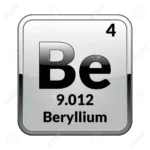
Lithium (Li) is a silver-gray metal with the atomic number three. Under normal conditions it is the lightest metal, but still the densest. Lithium has three protons in its nucleus with atomic number three, but like many other alkali metals it only has one valence electron.
Lithium is the lightest metal.
It is the least reactive of the alkalai metals.
Lithium has the lowest density of any metal. Lithium can float on water.
The nucleus of lithium is fairly unstable.
Lithium is a shiny, soft metal which reacts violently with water forming a strong corrosive base. Lithium is often stored in oil for this reason.
Because of this instability, lithium alone almost never appears in nature.
Lithium burns with a bright red color. Lithium is added to fireworks to make red sparks.
While it appears metallic and shiny, it begins to corrode immediately in air due to the moisture present.
Lithium is used extensively in rechargeable batteries. It is also used in many ceramics.
It is a metal, but soft enough to be cut with a knife.
Lithium is used as an alloy additive to aluminum and magnesium to lower weight and improve strength.
The first man-made nuclear reaction took place in 1932 when lithium was converted into helium through transmutation.
Lithium is not found in its elemental form. Lithium is produced by electrolysis of ores containing lithium.
Lithium is used in producing glass and ceramics, but most well-known for batteries.
The largest deposits of lithium containing ore are found in Chile.
Because of its great strength in small amounts, it is used in common alloys.
The first man-made nuclear reaction was the transmutation of lithium into tritium.
All organisms contain lithium in small amounts, but does not seem to serve a biological purpose.
Lithium carbonate is used in small doses to treat manic depression and bipolar disorders.
Lithium ions are used in creating mood-altering medications for the treatment of bipolar disorder.
Lithium deuteride was an early consideration for thermonuclear bomb fuel.
Lithium has two stable isotopes in nature, one of which has a 92.5% abundance.
Like other alkali metals, lithium can be used to create soap.
According to theory, lithium is one of three elements believed to have been created during the Big Bang.
Lithium soap is used in many commercial lubricants.
Lithium is very abundant in sea water and if often mined from brines and clay.
The lithium produces tritium which in turn fuses with the deuterium to release energy.
Lithium salts burn with a bright red flame.
Lithium-7 is the most common isotope. It contains 4 neutrons and accounts for 92.41% of all natural lithium.
The current availability of lithium is a deciding factor in the creation of larger batteries for electric car production.
Lithium-6 is a stable isotope of lithium containing three neutrons. 7.59% of natural lithium contains lithium-6.
Lithium has become carefully guarded since it is a key ingredient in the production of methamphetamine.









